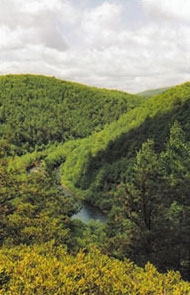Land Snail Ecology

Lehigh Gorge State Park, PA; by Ken Hotopp
Land Snails and Forest Calcium
Land snail shells, for those species that have them, are made mostly of calcium carbonate with a protein outer coating. Some wildlife obtain the nutrient calcium by consuming live land snails or their empty shells.
Calcium plays a variety of roles in the body of land snails and slugs, including parts in fluid regulation, cell wall function, muscle contraction, and egg laying, and of course, the shelled animals use a large amount of calcium in forming their shell structure. The shell-building organ, the mantle, develops a pH gradient to create a small electric current to move calcium ions into place. A few slugs such as the non-native Limax maximus have a small, vestigial shell that can be found within the mantle.
Land snails obtain calcium from their environment in a variety of ways, depending upon their autecology. They eat live and decaying leaves and wood, fungi and algae on wood and rocks, sap, animal scats and carcasses, nematodes, and other snails. They can be found rasping old or occupied snails’ shells, bones and antlers, rock particles or larger stones and outcrops, and the soil that they regularly consume contains calcium. In captivity they consume lime and paper. Land snails also absorb calcium directly through the sole of their foot (Kado, 1960).
Calcium availability in forest environments generally is positively correlated with the number and species richness of land snails (Burch, 1955; Hotopp, 2002; Beier et al, 2012). However, note that at the greatest levels of site calcium, snail numbers may actually be slightly reduced (Valovirta, 1968). Acid precipitation can reduce the amount of calcium in forest soils, and this in turn can depress snail numbers as much as 80% on sensitive sites (Wäreborn, 1992). Conversely, land snail numbers respond positively to the addition of calcium (Johannessen and Solhøy, 2001).
Calcium in forest soils can come from below, from the breakdown of bedrock and other parent material that contains calcium, but it also comes from above, in the form of plant debris (noting that plants have also obtained their calcium from soil and rock via roots). Plants use calcium in nutrient and water translocation, cell division and cell walls. The amount of calcium in tree leaves and other litter varies, so forest species composition influences soil calcium (Boettcher and Kalisz, 1990; Vesterdahl and Rauland-Rasmussen, 1998).
Soil profiles may exhibit declining or increasing calcium with depth, depending upon the calcium content of bedrock versus leaf litter. For our purposes the important issue is the amount of calcium available to land snails at the upper soil horizons where they live, generally the lower O and A1 horizons. Soil horizon effects may also be interrupted, by calcium-rich limestone outcrops or limestone scree that can make large quantities of this nutrient available to land snails (and other animals).
Tree species composition can be an important factor influencing leaf litter calcium, as some trees are better “calcium pumps,” having relatively more Ca in their leaves, or in the bark cambium layer of decomposing logs. This calcium must also be available to decomposers, in the form of water-soluble calcium citrate (as in ashes, maples, and birches), rather than tightly-bound calcium oxalate (as in oaks and laurels). Aspens, sugar maples, and flowering dogwood (e.g. Nation, 2007) are examples of high-calcium species. Circumstantial evidence suggests that fungi and other decomposers may also play an important role in mediating calcium available for land snails. Examples of leaf litter snails whose populations are finely-attuned to calcium levels are Punctum minutissimum and Striatura meridionalis. Many snails are calciphiles only found on the richest forest sites, such as Gastrocopta armifera.
Although calcium-rich areas have many species, an interesting variety of land snails exist across the calcium gradient, including calcium-poor sites. Some shelled snail species persist on poor sites in refuge habitats such as deep leaf litter, logs, or around springs. Others are acidophiles, specially-adapted to gleaning calcium from poor habitats. An example of an extreme acidophile is the bog and pocosin-dweller Vertigo malleata. Even large snails such as certain Triodopsis and Mesomphix species are adapted to calcium-poor environments.
Moving up the “food chain,” a variety of animals eat land snails. Many predators are after the protein in snail flesh, especially invertebrates such as beetle or fly larvae, while other predators are consuming calcium-rich eggs or shells as well. Gastropods are eaten by herptiles including turtles and salamanders; by mammals including shrews, mice, and squirrels; and by birds including thrushes, ruffed grouse and wild turkey (Martin et al., 1951). Ruffed grouse are reported to consume the slug Deroceras laeve, relatively low in calcium, but also the whitelip Neohelix albolabris, a large shelled snail.
Snail availability may be critical to calcium provisioning for some of these animals. Changes in snail numbers can have ripple effects through an ecosystem, as demonstrated for the great tit (Parus major) in the Netherlands (Graveland, 1996; Graveland et al. 1994). There, reduction in soil calcium due to acid rain resulted in fewer snails, which caused eggshell thinning and reduced reproductive success for the birds. Researchers in North America have also found negative correlations between acid rain and wildlife, such as wood thrush (Hylocichla mustelina; Hames et al, 2002) and salamanders (Beier et al, 2012). However, songbirds in high-elevation New England forests - where there are few snails - are apparently obtaining calcium from other invertebrates such as spiders.
The acid rain-soil calcium picture may be even more complex. Some work suggests that forest soils in Northeastern North America have become more acid as stands age, overriding the influence of acid rain by a wide margin (Hamburg, et al. 2003). In Sweden a study of clearcutting in boreal forest found a long-term increase in calcium and the number of most land snails (Ström, 2004), despite an initial snail decline. These studies show how younger trees are more effective “calcium pumps.”
At the other end of the forest age continuum, research suggests higher land snail numbers and species richness in old forest. In two of three old growth forests in Kentucky, land snail species richness and abundance were higher than in younger stands (Douglas et al, 2013). In old European beech stands, land snail numbers and species richness rose significantly after 187 years (Müller et al, 2005).
Important outstanding questions about soil calcium and forest age are the relative importance of tree species composition shifts; changes in coarse woody debris; differences in fungi and decomposers; and change in site moisture with age or management.
Ken Hotopp 2/2014



Development of this site was supported by the generous contributions of Pennsylvanians to the Wild Resource Conservation Fund, and by the Virginia Dept. of Game and Inland Fisheries with a State Wildlife Grant from the US Fish & Wildlife Service.
